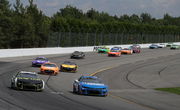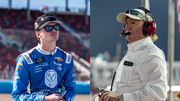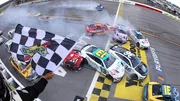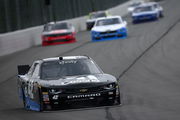
USA Today via Reuters
May 22, 2022; Fort Worth, Texas, USA; NASCAR Cup Series driver Daniel Suarez (99) and NASCAR Cup Series driver Tyler Reddick (8) lead the pack to a restart during the All-Star Open at Texas Motor Speedway. Mandatory Credit: John David Mercer-USA TODAY Sports

USA Today via Reuters
May 22, 2022; Fort Worth, Texas, USA; NASCAR Cup Series driver Daniel Suarez (99) and NASCAR Cup Series driver Tyler Reddick (8) lead the pack to a restart during the All-Star Open at Texas Motor Speedway. Mandatory Credit: John David Mercer-USA TODAY Sports
Folks, NASCAR veterans keep coming back for one-off appearances, and undoubtedly, that invokes a lot of nostalgia. An old-school driver battling the youngsters of the sport. What a storyline! Often, the Daytona 500 is a popular destination for such one-offs. As it kills two birds with one stone, drivers get to make comebacks to NASCAR while also running on the sport’s most iconic track in the sport’s most iconic race. And if you recall, NASCAR veteran Mike Wallace wanted to race in the 2025 Daytona 500.
But he was ruled out as he did not meet the minimum requirements. And this came after he’d already been promised an entry by NASCAR president Steve Phelps. Heartbreakingly, Wallace could not run the race that he had planned to do in honor of his late wife, Carla. After this incident, NASCAR received a lot of backlash over its approval process. How Wallace was denied entry, how Katherine Legge was approved to run an oval in her debut Cup race, Helio Castroneves’ case, the list is long. Recently, NASCAR has made a small change in the rule. And it’s feeling like more of a silence critics than to bring out something constructive.
ADVERTISEMENT
Article continues below this ad
NASCAR’s rule change for one-off drivers!
Folks, you got to feel for Wallace; he wanted it for his wife. He even got a ride with MBM Motorsports, now known as Garage 66, and got the sponsors. On top of that, he also passed the physical fitness test that active drivers go through in the off-season. According to him, Phelps had even confirmed his entry, as he posted a screenshot of an email from NASCAR that read, “I don’t anticipate any issues and will present to the group on Jan. 7”. But later, NASCAR senior vice president of competition Elton Sawyer clarified that Wallace had “never been approved.” This started the debate of inconsistencies in NASCAR’s approval process.
Technically, according to the NASCAR rule, both old and new, Wallace does not fit the requirements. Here’s the changed rule: “Submit the Driver Information and Record application to the NASCAR Resume Committee outlining his/her previous racing experience. The NASCAR Resume Committee will determine if the driver is approved to compete in the NASCAR Cup Series and, if approved, which types and sizes of racetracks the driver may compete. Any previously approved driver who has not competed in an approved Series for over 365 days may be required to resubmit the Driver Information and Record application.”
The previous rule read, ‘Any previously approved driver who has not competed in an approved Series for at least a year may be required to resubmit the Driver Information and Record application.’ The highlighted part is the change. Now, that’s not much of a change, and it feels like they are doing it to distract the NASCAR community from the inconsistencies being discussed. Now, it’s unclear what an ‘approved series’ means in this context. Katherine Legge was allowed entry based on her Indy 500 appearance last season. So was Helio Castroneves in the Daytona 500 this season. So, is running an open-wheel car enough to run a stock car in the Cup series?
NASCAR clarified an aspect of its Minimum Requirements in the rule book. There has been a lot of talk about this and the approval process, especially after the Mike Wallace debacle before Daytona. #NASCAR pic.twitter.com/gONJu3LTPi
— Jonathan Fjeld (@Jonathan_Fjeld) March 26, 2025
And Wallace has more experience in Superspeedway racing than both of them combined. The only difference is that Wallace has been inactive for a decade. The last Cup race he ran was the 2015 Daytona 500. But the question is whether NASCAR should weigh the one-year inactivity part over a driver’s experience running these tracks for several hundred laps. Clearly, in both Legge and Castroneves’s case, even though they have been active racers, they don’t have any Cup experience, and naturally, both ended in DNF. Rather, Legge even ruined Daniel Suarez‘s day at Phoenix by spinning out inadvertently and crashing into him.
Still, the inconsistencies in the approval process remain. Like how in Wallace’s case, NASCAR reasoned that it was ‘due to lack of recent races in major professional motorsports.’ Meanwhile, Casey Mears has been approved to run in the upcoming Martinsville race.
Trending
ADVERTISEMENT
Article continues below this ad
How is Casey Mears allowed to race in NASCAR despite being inactive?
So apparently, the ‘lack of recent races in major professional motorsports’ part of the rule doesn’t apply here! Mears last ran in the Cup Series in 2019 in the Daytona 500. That was six years ago. And Mears himself clarified that he was approved for Martinsville since it’s not a Superspeedway like the Daytona 500. He had written in an X post, “So the standard is to run 1.5 and under first. I wasn’t approved for Daytona or Talladega either. After running Martinsville I should be approved to run super speedways again. Apples to apples. Bummer for Mike, but we are in the same boat.”
How can running a short track prepare you for a Superspeedway? We get that Superspeedway racing is dangerous and fast, but this current process makes no sense. And it’s not just a short track, a driver can also opt to run a road course race first and then get approved for a Superspeedway. NASCAR’s logic here is that a driver would get accustomed to the Next-Gen car, making him better suited for drafting tracks. But this rule should probably have an exception for stock car racing veterans. Wallace would hardly take any time to adapt to the next-gen. A few practice laps and some sim time could have been enough.
And NASCAR, in his case, cannot ignore his previous Superspeedway experience. He’s run close to more than 37 Superspeedway races in his 197 starts at the Cup level. But if he wants to run a Superspeedway again, it’s a quite lengthy process. NASCAR Journalist Matt Weaver had previously explained what Wallace was to do if he had to run at the Daytona 500: “Run an intermediate track Xfinity race, an Xfinity superspeedway race and then a short track or road course Cup race to get acclimated to the Next Gen car. Then he would need to run a Cup speedway race — all during the 2025 season.” That’s a lot for a driver looking for a one-off appearance.
ADVERTISEMENT
Article continues below this ad
What do you think, folks, about the approval process? Share your thoughts with us in the comments below.
ADVERTISEMENT
ADVERTISEMENT
ADVERTISEMENT
ADVERTISEMENT






